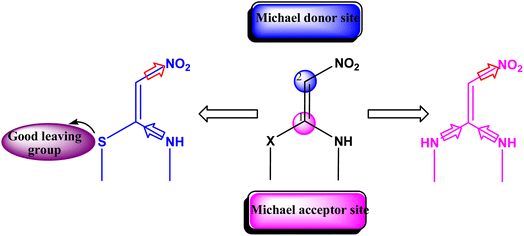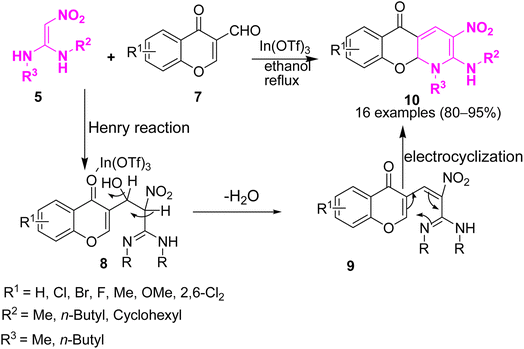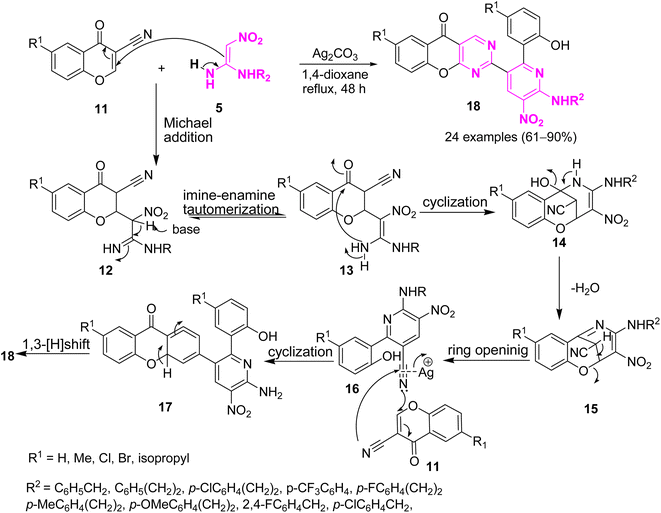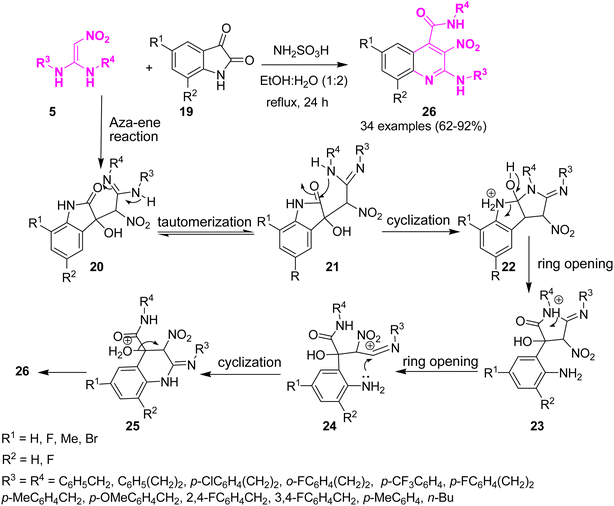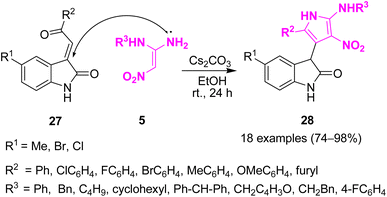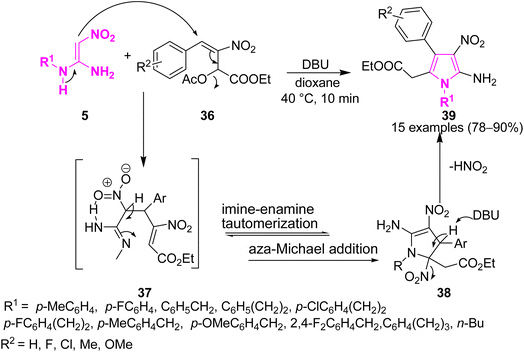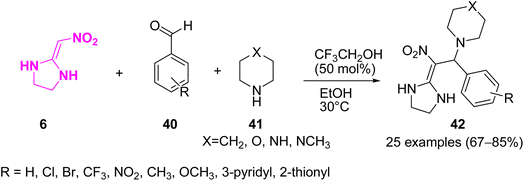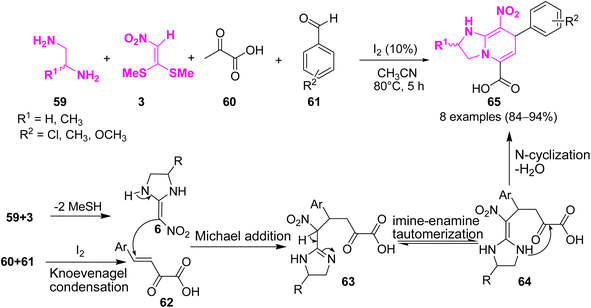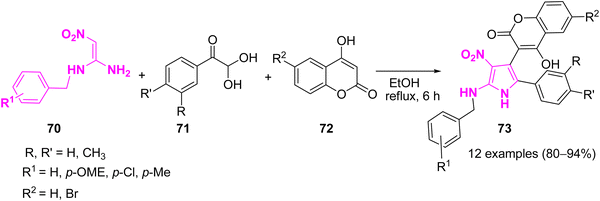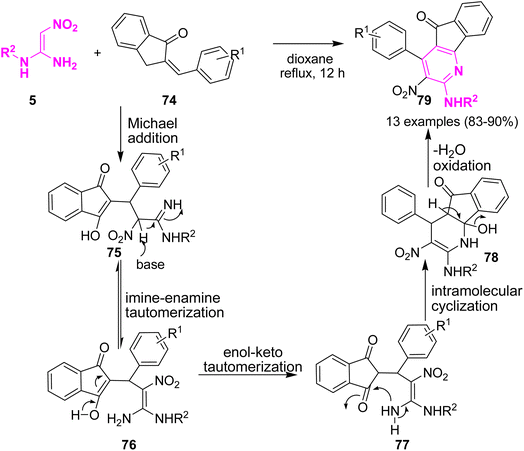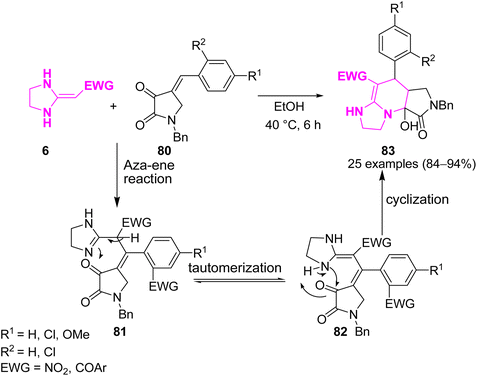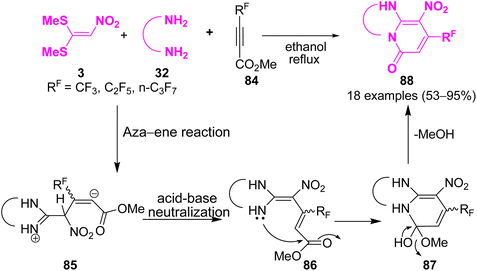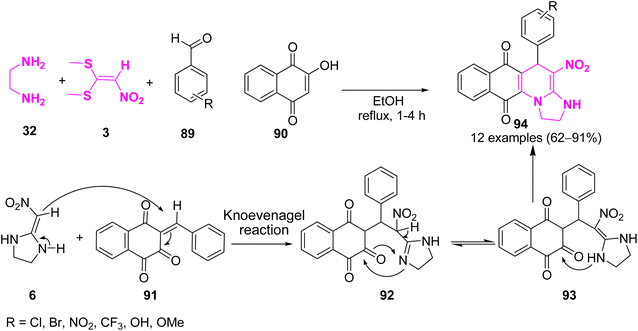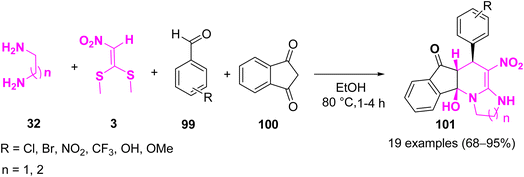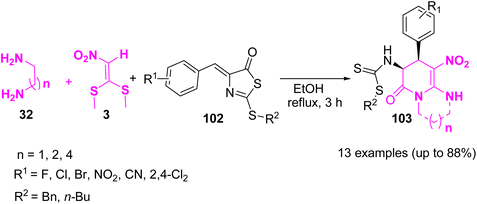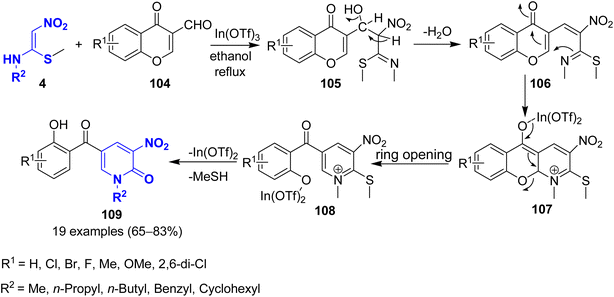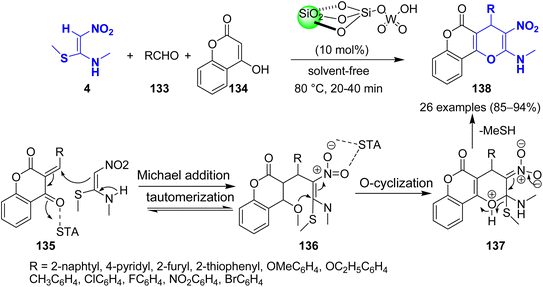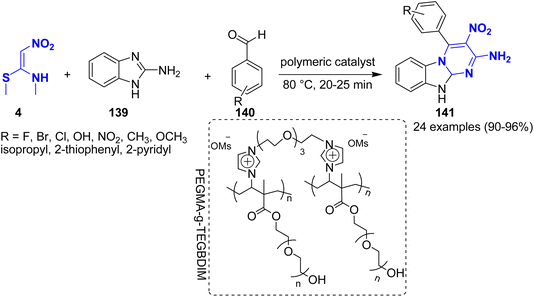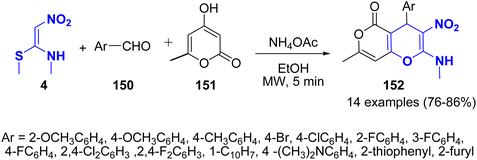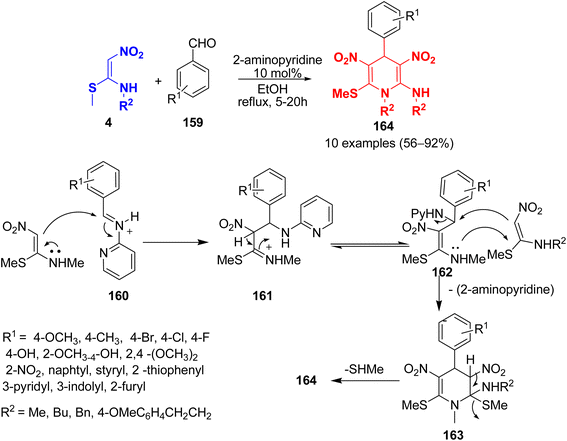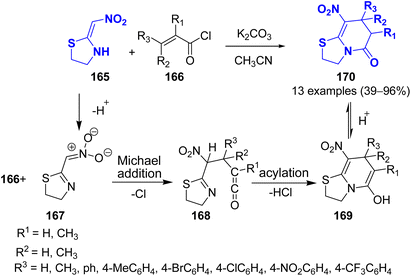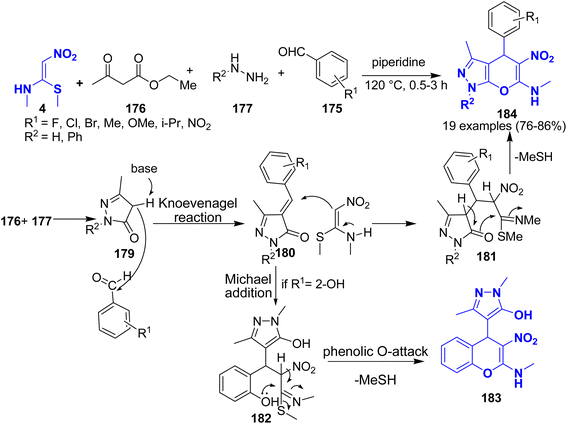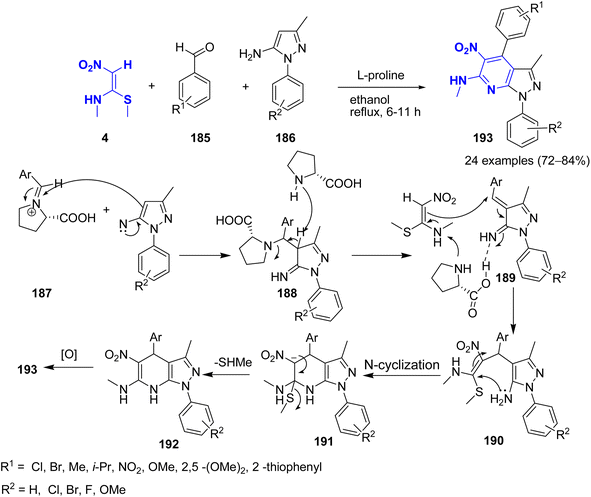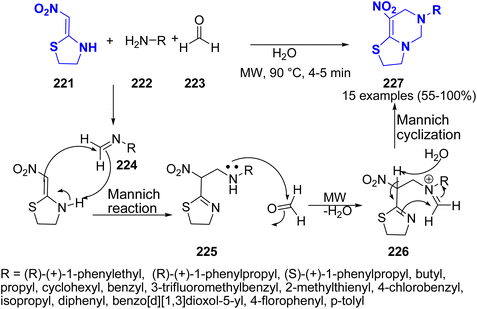 Open Access Article
Open Access ArticleNitroenediamines (EDAMs), and N-methyl-1-(methylthio)-2-nitroethenamine (NMSM) derivatives: scaffolds for heterocycle molecular diversity (update from 2012 to 2021)
Fahimeh Abedinifar ,
Bagher Larijani and
Mohammad Mahdavi
,
Bagher Larijani and
Mohammad Mahdavi *
*
Endocrinology and Metabolism Research Center, Endocrinology and Metabolism Clinical Sciences Institute, Tehran University of Medical Sciences, Tehran 14176, Iran. E-mail: Momahdavi@sina.tums.ac.ir
First published on 26th October 2022
Abstract
Nitro-1,1-enediamines (EDAMs) and 1,1-bis(methylthio)-2-nitroethene (NMSN) have proven to be a class of attractive and useful synthetic building blocks for use in the synthesis of heterocyclic and fused heterocyclic compounds. The bicyclic or tricyclic heterocycles derived from these frames widely exist in natural and synthetic drugs. To comprehend the reaction properties of EDAMs and NMSN and to design other novel fused heterocycles with biological effects in the future, it is essential to investigate their recent reactions. The current review envisions highlighting some recent and remarkable examples of nitroenediamine reactions categorized by catalyst-assisted and catalyst-free reactions from 2012 onward.
1. Introduction
Nitro-1,1-enediamines (EDAMs) with the formula and structural features illustrated in Scheme 1, are fascinating and versatile building blocks that have been widely applied to synthesize a variety of functionalized fused heterocyclic compounds with diverse pharmacological activities including antitumor,1–3 antibacterial,4 and antileishmanial.5 EDAMs as bisnucleophilic reagents could react with various electrophiles to prepare highly functionalized heterocycles.The reactant N-methyl-1-(methylthio)-2-nitroethenamine (NMSM) contains four active sites with three functional groups on an ethene motif, as shown in Scheme 1. A strongly electron-withdrawing nitro group makes the nitroethylene substructure a good Michael acceptor. Besides, the methylthio group acts as a leaving group and electron donor to make the C2 a good Michael donor. Also, the secondary amine group is an electron-donor. Overall, the ethylene moiety is a polarized push–pull alkene with C1 showing electrophilic character and C2 showing nucleophilic character. NMSM, with all these characteristics, is an important reactant that may cause the products more valuable as medical intermediates and in synthesizing a variety of oxygen and nitrogen-containing heterocyclic compounds.
Cyclic enediamine with a carbonyl group on α-carbon atom is known as heterocyclic ketene aminals (HAKs).6 These compounds are generally categorized as good nucleophiles in organic reactions. Furthermore, replacement of nitro group on α-carbon generates a new class of HKAs and will be discussed in this review.
All of ketene aminals, keten thioacetals and nitroenediamines are interesting synthons and readily synthesized through the reaction have been summarized in Scheme 2. The most common method of synthesizing these compounds is the condensation of nitromethane 1 with carbon disulfide in the presence of KOH in ethanol solvent that makes compound 2. The reaction of compound 2 and dimethyl sulfate generates the nitro ketene dithioacetal-1-nitro-2,2-bis(methylthio)ethylene 3 that is a precursor in the synthesis of nitroenamine derivatives. The reaction of 3 with various amine (one equivalent or excess amounts) obtains the corresponding mono substituted 4 or keten aminals 5. Also, the elimination of two molecules of R1SH from 1,1-bis (methylthio)-2-nitroethene 3 in reaction with diamines affords cyclic nitro-ene-1,1-diamine 6 (Scheme 2).7,8
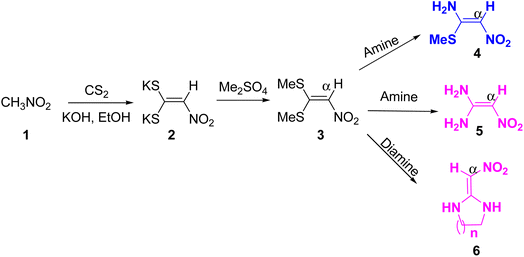 | ||
| Scheme 2 Synthesis of cyclic/acyclic nitro-1,1-enediamines and N-methyl-1-(methylthio)-2-nitroethenamine. | ||
Work in the field of heterocyclic ketene aminals (HKAs) prior to 2014 was reviewed by Wang6 and in current review, we will investigate the relevant examples of heterocyclic ketene aminals containing nitro groups. This review summarizes the recent progress in heterocycle synthesis from 2012 to 2021. Its aim is to give an overview of the rich reactivity of nitroenediamines in multi-component reactions. This review is divided into two significant parts according to reagent and divided into subsections based on catalytic and non catalytic pathways for further clarification.
2. Nitroenediamine derivatives in heterocyclization
In this section, the reaction of cyclic and acyclic nitroenediamine have been described especially focusing on some important mechanisms. Since cyclic nitroenediamine is obtained from reactions 1,1-bis(methylthio)-2-nitroethene and diamines, these reactions are also investigated in this section.2.1. Catalysts-assisted approaches
Indium salts are considered a non-toxic valuable catalyst in organic transformations. An indium triflate-catalyzed reaction of (Z)-N-methyl-1-(methylthio)-2-nitroethenamine 5 with 3-formylchromone 7 achieved the azaxanthone derivatives 10 in good yields (up to 88%).9 Mechanistically, In(OTf)3 promotes the Henry reaction of 3-formylchromone 7 with N,N-dialkyl-2-nitro-ethene-1,1-diamine 5 to generate intermediate 8. In the following, the removal of water makes the intermediate 9 which undergoes 6π-electrocyclization to afford the final product 10 (Scheme 3).Xiao and coworkers reported the silver-catalyzed synthesis of 2-(pyridin-3-yl)-chromeno[2,3-d]pyrimidine derivatives 12 via electrocyclization cascade reaction of 3-cyanochromone 11 and 1,1-enediamines 5 under reflux in 1,4-dioxane for 48 hours. Importantly, one C–C bond and three C–N bonds were formed, and one bond was broken in one-pot organic transformation (Scheme 4).10
Based on proposed mechanism, the nucleophilic Michael addition of nitroenediamine 5 with 3-cyanochromone 11 forms the intermediate 12. The imine–enamine tautomerization of 12 and further intramolecular 1,2-addition involving the primary amine leads to cyclic intermediate 14. Water removal and ring opening of intermediate 15 is promoted by silver carbonate to afford intermediate 16. Finally, the electrocyclization reaction of intermediate 16 with another 3-cyanochromone molecule 11 gives intermediate 17 which undergoes a 1,3-migration of hydrogen to obtain 2-(pyridin-3-yl)-chromeno[2,3-d]pyrimidines 18.
A valuable and efficient reaction of isatins 19 and 1,1-enediamines 5 catalyzed by NH2SO3H to synthesize corresponding multisubstituted quinoline-4-carboxamides 26 was reported by Yan and co-workers (Scheme 5).11 Mechanistically, the aza-ene reaction of EDAMs 5 with isatine 19 gives the intermediates 20. Then, tautomerization followed by intramolecular cyclization makes intermediate 22. Intermediate 22 is converted into intermediate 24 via two ring-opening reactions. The primary amino groups of intermediate 24 attacks the imine ion to produce the intermediate 25 which then undergoes a cyclization reaction and tautomerization to produce 26.
In 2021, Yan and colleagues disclosed the cascade reaction of the (E)-3-(2-oxo-2-phenylethylidene)indolin-2-one derivatives 27 and cyclic and acyclic EDAMs 5 and 6.12 Applying acyclic EDAM substrates 5 in this reaction led to formation of 4-(2-oxoindolin-3-yl)-1H-pyrroles 28 via the selective nucleophilic attack of the amine on the more electron-deficient carbonyl (ArC![[double bond, length as m-dash]](https://www.rsc.org/images/entities/char_e001.gif) O) of compound 27 rather than the amide group (NHCO). The R1 group greatly affected the yields of 28, such that electron-withdrawing groups manifested higher yield of the products compared to electron-donating groups (Scheme 6).
O) of compound 27 rather than the amide group (NHCO). The R1 group greatly affected the yields of 28, such that electron-withdrawing groups manifested higher yield of the products compared to electron-donating groups (Scheme 6).
The selective Michael addition of cyclic enediamine 6 to the unsaturated double bond of (E)-3-(2-oxo-2-phenylethyl-idene) indolin-2-one derivatives 27 in the presence of Cs2CO3 as the base at room temperature after 12 hours makes α-carboline 34 in excellent yields. To the surprise, the methodology for the same reactants in a longer time after 48 hours obtained the more stable α-carbolines 35. Herein, tautomerization followed by intramolecular cyclization provides intermediate 31 that is transform into 34 under oxygen and losing two water molecules (Scheme 7).
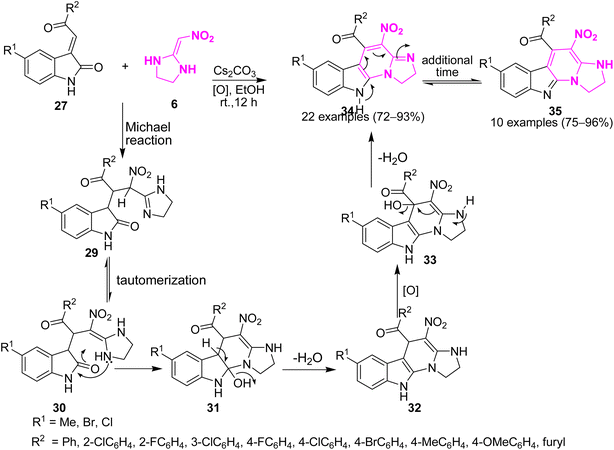 | ||
| Scheme 7 Site-selective synthesis of highly functionalized 2,10-dihydro-1H-imidazo[1′,2′:1,6]pyrido[2,3-b]indoles 34 and pyrroles 35. | ||
Yan et al. in 2019, explored the DBU-promoted tandem reaction of different Morita–Baylis–Hillman (MBH) acetates 36 with the different EDAMs 5 to access fully substituted-2-amino pyrroles 39. The results revealed that the electron-withdrawing group (F and Cl)-substituted of the MBH acetates can achieve a higher yield than the electron-donating group (MeO) and the reaction with N-phenyl EDAMs and N-alkyl-EDAMs gives higher yields than N-benzyl-EDAMs (Scheme 8).13
The α-C of EDAMs 5 begins the nucleophilic Michael addition to MBH acetates 36 that is accompanied by the elimination of the acetate group through an SN2′ mechanism to generate intermediate 37. Imine–enamine tautomerization of intermediate 37 and further intramolecular aza-Michael addition promoted by DBU results in intermediate 38. Finally, aromatization by elimination of HNO2 yields fully substituted 2-aminopyrroles 39.
Li et al. investigated the effect of 2,2,2-trifluoroethanol catalyst on the Mannich-like reaction of β-nitroenamines 6, amines 41, and aromatic aldehydes 40. TFEA was added to establish the hydrogen bond with aromatic aldehydes to increase its electrophilicity (Scheme 9).14
Hasaninejad et al. reported the preparation of pyrrolo[1,2-a]pyrimidine derivatives 28 via the reaction of bromoacetophenone 43 and 2-nitroethene-1,1-diamines 6 in the presence of K2CO3 (Scheme 10).15 The aza-ene reaction between bromoacetophenone 43 and 2-nitroethene-1,1-diamine 6 gives intermediate 44, which is tautomerized and subsequent intramolecularly cyclized to produce 45.
Shao and coworkers prepared bridged heterocycles 53 from one-pot reaction of ninhydrin 46, malononitrile 47, and nitroendiamine 6 in high yields (Scheme 11).16
Knoevenagel condensation of malononitrile 47 with ninhydrin 46 forms intermediate 48 that undergoes Michael addition of the nitro ketene aminal (NKA) 6 to give intermediate 49. The chemoselective nucleophilic attack of the NH of the resulted intermediate 50 at the carbonyl function affords intermediate 51. Then, O-cyclization and tautomerization of imino group to amino group of 51 could lead to fused oxa-aza[3.3.3]propellanes 53.
The elimination of two molecules of R1SH from 1,1-bis (methylthio)-2-nitroethene 3 in presence of diamine 32 affords cyclic nitro ene-1,1-diamine 6.8 Alizadeh's group developed an efficient route to synthesis of 1,4-dihydropyridine-fused-1,3-diazaheterocycle derivatives 58 by refluxing a mixture of 1,1-bis(methylthio)-2-nitroethylene 3, 1,n-diamine 32, arylaldehyde 54, and malononitrile 47 in ethanol and 10 mol% of piperidine as a basic catalyst (Scheme 12).17
 | ||
| Scheme 12 Synthesis of 1,4-dihydropyridine-fused-1,3-diazaheterocycle 58 via multi-component reaction. | ||
Rezvanian reported I2-promoted reaction of aldehyde 61, pyruvic acid 60, aliphatic diamines 59, and 1,1-bis(methylthio)-2-nitroethylene 3 in synthesis of 1,2,3,7-tetrahydroimidazo[1,2-a]pyridine-5-carboxylic acids 65 (Scheme 13).18
Deep eutectic solvents (DES) consist of halide salt of a quaternary ammonium or phosphonium cation with a hydrogen bond donor (HBD), for example, urea, carboxylic acids, or ethylene glycol. DESs could be used as drug solubilization vehicles for drug delivery research. DES also possess several key characteristics as liquids to support a wide variety of substrates and enzymes.19 Shaabani and co-workers used the DES by mixing choline chloride (ChCl) and urea to activate the carbonyl and cyano groups in a domino four-component reaction to get fully-substituted naphthyridines 69 (Scheme 14).20
 | ||
| Scheme 14 Synthesis of fully-substituted naphthyridine 69 through domino four-component reaction in deep eutectic solvent. | ||
2.2. Catalyst-free approaches
A novel approach was developed for the synthesis of 2-amino-4-coumarinyl-5-arylpyrroles 73 through a metal-free cascade reaction of arylglyoxal monohydrates 71, 1,1-enediamines (EDAMs) 70 and 4-hydroxy-2H-chromen-2-ones 72 (Scheme 15).21A cascade reaction of 1,1-enediamines 5 with benzylidene-1H-indene-1,3(2H)-diones 74 in ethanol without any catalysts obtained the products 79. In this reaction, EDAM 5 attacks the C![[double bond, length as m-dash]](https://www.rsc.org/images/entities/char_e001.gif) C bond of benzylidene to promote the Michael addition reaction. The imine–enamine tautomerization of intermediate 75 makes 76. Then, the intermediate 77 is obtained through the enol–keto tautomerization of intermediate 76. The intramolecular cyclization of the intermediates 77 where the amino group attacks the carbonyl provides intermediate 78. Finally, water removal and oxidation of intermediate 78 affords target 79 (Scheme 16).22
C bond of benzylidene to promote the Michael addition reaction. The imine–enamine tautomerization of intermediate 75 makes 76. Then, the intermediate 77 is obtained through the enol–keto tautomerization of intermediate 76. The intramolecular cyclization of the intermediates 77 where the amino group attacks the carbonyl provides intermediate 78. Finally, water removal and oxidation of intermediate 78 affords target 79 (Scheme 16).22
The aza-ene reaction of HKAs 6 and dioxopyrrolidines 80 without any catalysts in ethanol constructed imidazo[1,2-a]pyrrolo[3,4-e]pyridines 83 with good to excellent yield (Scheme 17).23
Wang et al. devised the synthesis of perfluoroalkyl-substituted 2-oxopyridine-fused 1, 3-diazaheterocycles 88 via one-pot reaction of diamines 32, ketene dithioacetals 3, and 2-perfluoroalkynoates 84. Mechanistically, in situ cyclic ene-1,1-diamine 6 participates in aza-ene reaction with 2-perfluoroalkynoate 84 to give 85. An intramolecular imine–enamine tautomerization followed by cyclization makes desired products 88 (Scheme 18).24
Bayat et al. synthesized benzo[g]imidazo[1,2-a]quinolinedione derivatives 95 from the multi-component reaction of ethylenediamine 32, 1,1-bis(methylthio)-2-nitroethene 3, 2-hydroxy-1,4-naphthoquinone 90 and aromatic aldehydes 89 (Scheme 19).25 The proposed mechanism reveals that ketene aminal 6 from ethylenediamine 32 and 1,1-bis (methylthio)-2-nitroethene 3 attacks Knoevenagel adduct of the aldehyde 89 and 2-hydroxy-1,4-naphthoquinone 90 to afford intermediate 92. The intermediate 92 under imine–enamine tautomerization and nucleophilic addition of the secondary amino group to the more reactive carbonyl group gives product 94.
In 2017, Bayat's group applied cyanoacetohydrazide 96 instead of naphthoquinone 90 in similar pathway to produce imidazo[1,2-a]pyridine-6-carbohydrazide derivatives 98 at a short time (Scheme 20).26
They also used this strategy in stereoselective synthesis of indenone-fused heterocycles 101 (Scheme 21).27
In 2021, Ziyaei et al. utilized thioazlactones 102 and ketene aminals for the synthesis of bicyclic pyridone containing the dithiocarbamate group through domino amidation/intramolecular 1,4-addition-type/Friedel–Crafts alkylation reactions (Scheme 22).28
3. (Methylthio)-2-nitroethenamine derivatives (NMSM) in heterocyclization
3.1. Catalysts-assisted approaches
An indium triflate-catalyzed reaction of (Z)-N-methyl-1-(methylthio)-2-nitroethenamine 4 with 3-formylchromone 104 achieved the 2-pyridone analogues 109 in good yields (up to 88%). As mentioned earlier, In(OTf)3 promotes the Henry reaction of 3-formylchromone 104 with (E)-N-methyl-1-(methylthio)-2-nitroethenamine 4 (NMSM) to give intermediate 105. Water removal makes intermediate 106 that undertakes N-cyclization, followed by chromone ring opening to provide 108. At sequence, the elimination of MeSH and In(OTf)3 affords the target 109 (Scheme 23).9Perumal et al. developed a novel procedure in spiroxindoles 115 via domino Knoevenagel condensation/Michael addition/intramolecular O-cyclization reaction of isatins 110, pyrazoles 111, and (E)-N-methyl-1-(methylthio)-2-nitroethenamine 4 in the presence of InCl3 as catalyst (Scheme 24).29
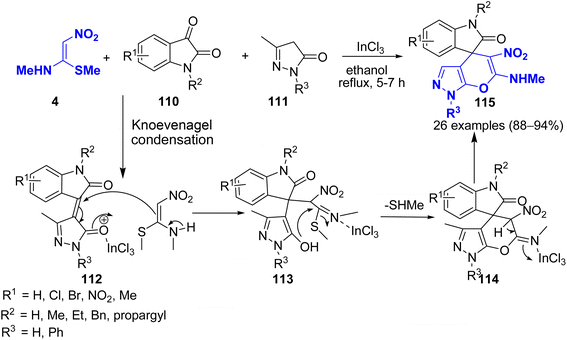 | ||
| Scheme 24 Synthesis of spiroxindoles 115 through InCl3-catalyzed reaction of N-methyl-1-(methylthio)-2-nitroethenamine. | ||
Rong and co-workers established copper-catalyzed construction of various isoxazolines 122 through the 1,3-dipolar cycloaddition reaction of styrene derivatives 116 and 4H-1,2-oxazete 118 in situ resulting from N-alkyl(aryl)-1-(methylthio)-2-nitroethenamine 4.30 The tautomerization and combination of substrate 4 with CuCl invited by the amino group generates intermediate 117 that smoothly transforms into intermediate 118. Elimination of methanethion from intermediate 118 makes intermediate 4H-1,2-oxazete 119 which yields 1,3-dipolar cycloaddition reaction with olefin 116 to obtain target 122 (Scheme 25).
Perumal et al. applied 4-hydroxy-1-methylquinolin-2(1H)-one 123 in Knoevenagel condensation domino reaction of aldehydes and N,S-methylacetal in catalytic amount of ZnCl2 (Scheme 26).31
ZnCl2 catalyst was also used in the synthesis of novel 2-methyl-6-(methylamino)-5-nitro-4-(4-aryl)-4H-pyran-3-carboxylate derivatives 132. This domino, one-pot reaction was performed for β-ketoesters 131, aromatic aldehydes 130, and (E)-N-methyl-1-(methylthio)-2-nitroethenamine (NMSM) 4 under the neat condition (Scheme 27).32
Jeong et al. applied silica-supported tungstic acid (STA) as a catalyst in multi-component reaction to obtain pyrano[3,2-c]chromen-5-ones 136 in green condition through Knoevenagel condensation, Michael addition, imine–enamine tautomerism, intramolecular O-cyclization, and elimination of MeSH (Scheme 28).33
Kim's research group reported the synthesis of heterogeneous polymeric catalyst based on ion liquids. Polyethylene glycol methacrylate-grafted tetra-ethylene glycol-bridged dicationic imidazolium (POEGMA-g-TEGBDIM), with its terminal hydroxyl groups, not only generates hosting sites for the reactants but also activates the starting materials to promote a three-component reaction of 1H-benzo[d]imidazole-2-amine 139, aryl aldehydes 140, and (E)-N-methyl-1-(methylthio)-2-nitroethenamine 4 to afford corresponding aryl-benzo[4,5]imidazo[1,2-a]pyrimidine amines 141 (Scheme 29).34
The Pot, Atom, and Step Economy (PASE) approach leads to simplicity, high yields and low waste formation in MCR chemistry and in the synthesis of heterocycles.35 This approach was adopted for the synthesis of benz[4,5]imidazo[1,2-a]purine derivatives 144 via consecutive reduction/auto-aromatization/heterocyclization of 2-aminobenzimidazoles 142, aromatic aldehydes 143, and N-alkyl-1-(methylthio)-2-nitroethylene-1-amines 4 refluxing in n-BuOH for three hours in the presence of 10 mol% [BMIM][BF4] (Scheme 30).36
 | ||
| Scheme 30 [BMIM][BF4]-assisted synthesis of 3-nitro-imidazo[1,2-a]pyrimidin-2-amine derivatives 144. | ||
In 2012, chromen-5-ones 149 and pyrano[3,2-c]chromen-5-ones 147 were synthesized through tandem reaction of NMSM 4, aromatic aldehydes 145, and 4-hydroxycoumarin 148 or dimedone 146 in the presence of catalytic amount of piperidine in ethanol (Scheme 31).37
 | ||
| Scheme 31 Synthesis of chromen-5-ones 149 and pyrano[3,2-c]chromen-5-ones 147 in presence of piperidine catalyst. | ||
In 2018, Khan and colleagues reported the similar reaction of cyclic-1,3-diketones, aromatic aldehydes, and NMSM in catalyst-free neat condition at 110 °C to generate 4H-chromen-5-one derivatives.38
Microwave irradiation facilitated the reaction of aromatic aldehyde 150, 4-hydroxy-6-methyl-2-pyrone 151 and N-methyl-1-(methylthio)-2-nitroethenamine 4 to produce pyrano[4,3-b]pyran-5-one derivatives 152. Ammonium acetate catalyzed the reaction in ethanol and the microwave power higher than 200 watts decomposed the substrates (Scheme 32).39
N-Methyl-1-(methylthio)-2-nitroethenamine 4, aromatic amines 154, and phenylglyoxal monohydrate 153 reacted in the presence of 10 mol% of iodine as catalyst. Both electron donating and weak withdrawing groups on aromatic amines except for nitro group gave desired products 120 in excellent yields (Scheme 33).40 At first, the reaction between aromatic amines 154 and phenylglyoxal monohydrate 153 leads to the imine 155 that is activated in presence of molecular iodine. Mannich type reaction between iodine activated imine 155 and NMSM 4 generates intermediate 156 which undergoes intramolecular cyclization to afford 158.
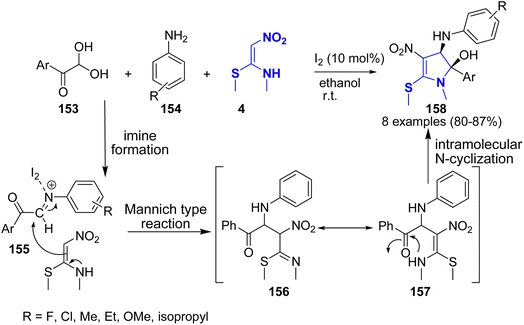 | ||
| Scheme 33 Iodine-catalyzed reaction of N-methyl-1-(methylthio)-2-nitroethenamine, aromatic amines, and phenylglyoxal. | ||
Prakash Rao and Parthiban developed an easy route to highly functionalized hexa-substituted 1,4-dihydropyridines.41 They used one equivalent of aldehydes 159, two equivalents of NMSM 4, and 10 mol% of 2-aminopyridine as catalyst refluxing in ethanol (Scheme 34). Mechanistically, at the first step, benzaldehyde 159 reacts with aminopyridine to make the iminium ion 160. The reaction of the iminium ion 160 with one equivalent of NMSM generates intermediate 161, which quickly rearranges to the more stable intermediate 162. One more unit of NMSM reacts with intermediate 162 to generate intermediate 163 and 2-aminopyridine. Finally, an intramolecular elimination of methanethiol from 163 gives dihydropyridines 164. A similar approach was designed to synthesize N-methyl-1,4-dihydropyridine derivatives in good yields under microwave irradiation without any solvents within 10 minutes.42
Aza-Michael annulation of 2-nitromethylene thiazolidine 165 with suitable Michael acceptors 166 using K2CO3 as the base afforded tetrahydrothiazolo[3,2-a]pyridinones 170 in good yields (Scheme 35).43 Based on proposed mechanism, in the presence of K2CO3, 2-nitromethylene thiazolidine 165 forms nitronic acid salt intermediate 167 by tautomerization. Next, Michael addition of 166 with the nitronic acid 167 gives imino-ketene intermediate 168. Then an acylation of imine nitrogen followed by HCl removal results in ring closure and affords thiazolopyridinones 170.
In 2015, Perumal et al. recorded the synthesis of 3-nitro-N-aryl/alkylthiophen-2-amines through the reactions of α-nitroketene N,S-alkyl amino acetals 4 and 1,4-dithiane-2,5-diol 171. Mechanistically, 1,4-dithiane-2,5-diol 171 is decomposed in the presence of K2CO3 to generate 2-mercaptoacetaldehyde 172. The nucleophilic addition of compounds 4 to the carbonyl of intermediate 172 followed by the addition of the thiolate anion makes the iminium intermediate 173. Addition of thiolate anion to the iminium functionality generates 174. Subsequent, elimination of methylmercaptan and water from 174 produces the thiophene derivatives 175 (Scheme 36).44
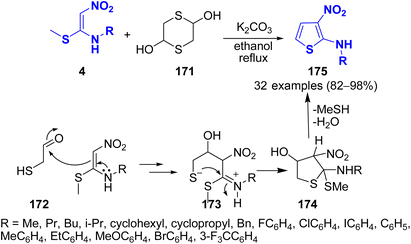 | ||
| Scheme 36 Synthesis of thiophen derivatives 175 from N,S-alkyl amino acetals 4 and 1,4-dithiane-2,5-diol 171. | ||
In 2013, Paramasivan et al. applied a catalytic amount of piperidine in the domino four-component reaction of ethyl acetoacetate 176, hydrazine hydrate 177, substituted aldehydes 178 with the NMSN 4 under solvent-free conditions at 120 °C to achieve pyranopyrazoles derivatives 184 or chromenopyrazoles 183.45 They proposed two different mechanisms for targets. The condensation of ethyl acetoacetate 176 with hydrazine hydrate 177 gives pyrazolone 179 that undergoes Knoevenagel reaction with aldehydes to give Michael acceptor 180. The adduct 180 immediately undergoes Michael-type addition with nitroketene-N,S-acetal (NMSM) 4 to generate the open chain intermediate 181 or 182. If the aldehyde is salicylaldehyde, the oxygen attack of phenol occurs to get 182. Otherwise, the oxygen of pyrazolone attacks imine to generate new intermediate. Finally, the elimination of MeSH from consistent intermediates leads to chromenopyrazoles 183 or pyranopyrazoles 184 (Scheme 37).
An equimolar mixture of dimethyl acetylenedicarboxylate (DMAD), hydrazine, aromatic aldehyde, and (E)-N-methyl-1-(methylthio)-2-nitroethenamine in the presence of N,N-diisopropylethylamine(DIPEA) refluxing in ethanol generated the 1,4-dihydropyrano[2,3-c]pyrazol-6-amines via domino cyclization Knoevenagel condensation/Michael addition/tautomerism/intramolecular O-cyclization/elimination sequences.46
3-Methyl-1-phenyl-1H-pyrazol-5-amine 187 in the presence of green catalyst, L-proline, enabled to react with N-methyl-1-(methylthio)-2-nitroetheneamine 4, and different aldehydes 186 to produce N,3-dimethyl-5-nitro-1-aryl-1H-pyrazolo[3,4-b]pyridin-6-amines 193 in good yields (Scheme 38).47 The reaction of aromatic aldehyde 185 with L-proline generates the iminium species 187. Then, the reaction between 3-methyl-1-aryl-1H-pyrazol-5-amine 186 and the iminium species 187 provides pyrazoloheterodiene 189 via intermediate 188. Subsequently, the Michael addition of the nitroketene N,S-acetal 4 to 189 produces the intermediate 190, which under intramolecular annulation affords the tetrahydropyrazolopyridine intermediate 191. Elimination of methanethiol from 191 results in the formation of dihydropyrazolopyridine, 192, which undergoes air oxidation to obtain pyrazolopyridine 193.
Shao and coworkers prepared bridged heterocycle 195 from one-pot reaction of ninhydrin 46, malononitrile 47, and 1-(methylthio)nitroenamine 4 under mild condition (Scheme 39).16 The mechanism reaction has been mentioned earlier in Scheme 11.
The mixture of benzoylacetonitrile 196, aromatic aldehyde 195 and (E)-N-methyl-1-(methylthio)-2-nitroethenamine 4 was refluxed in EtOH in the presence of triethylamine to obtain penta-substituted 4H-pyrans 197 in excellent yield (Scheme 40).48
The reaction of N-methyl-1-(methylthio)-2-nitroetheneamine 4, different aldehydes (benzaldehydes/heterocyclic aldehydes) 198 and 3-amino-1,2,4-triazole 199 under a mild condition in the presence of trichloroacetic acid (TCAA) as a Brønsted–Lowry acidic promoter generated N-alkyl-6-nitro-3,5-dihydro-[1,2,4]triazolo[1,5-a]pyrimidin-7-amine 202. The reaction followed via domino Mannich-type reaction, N-cyclization, and oxidation. Anti-tumor activity of the synthetic library was also evaluated (Scheme 41).49
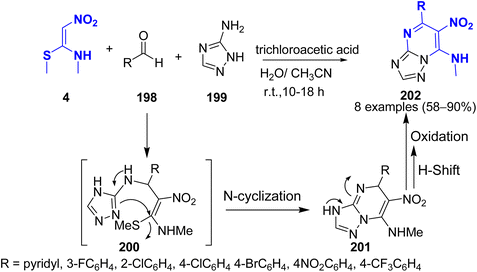 | ||
| Scheme 41 Brønsted–Lowry acid-promoted reaction of NMSN 4, aldehydes 198, and 3-amino-1,2,4-triazole 199. | ||
In 2020, Rong et al. suggested a method for the synthesis of pyrazolo[3,4-b]pyridine 206 and pyrano[2,3-c]pyrazole 207 through multi-component condensation of benzaldehyde derivatives 204, isatins 205, N-methyl-1-(methylthio)-2-nitroethen-1-amine 4, 3-aminopyrazole 203, and p-toluenesulfonic acid as the catalyst (Scheme 42).50
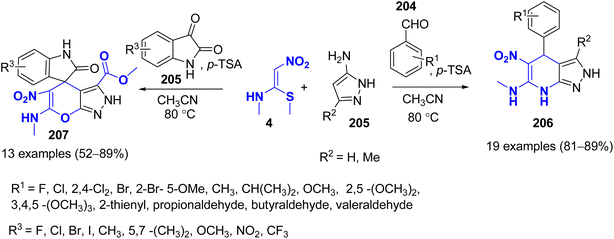 | ||
| Scheme 42 Synthesis of pyrazolo[3,4-b]pyridine 206 and pyrano[2,3-c]pyrazole 207 from N-methyl-1-(methylthio)-2-nitroethen-1-amine 4. | ||
Jeong et al. designed three-component reaction of 2-aminobenzimidazole 139, aldehydes 208, and (E)-N-methyl-1-(methylthio)-2-nitroethenamine 4, in the presence of catalytic amount of p-toluenesulfonic acid (p-TSA) for the synthesis of N-methyl-3-nitro-aryl-benzo[4,5]imidazo[1,2-a]pyrimidin-2-amine derivatives 209 (Scheme 43).51
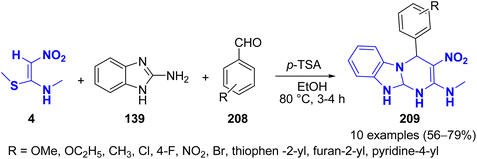 | ||
| Scheme 43 Synthesis of N-methyl-3-nitro-aryl-benzo[4,5]imidazo[1,2-a]pyrimidin-2-amine derivatives 209. | ||
Recently, Li et al. synthesized chromeno[2,3-b]pyridine derivatives 211 through the annulation of 2-amino-3-formylchromones 210 and various 1-(methylthio)-2-nitroenamines 4 in the presence of CF3SO3H an acidic catalyst (Scheme 44).52
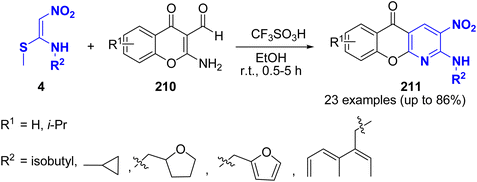 | ||
| Scheme 44 CF3SO3H-catalyzed reaction of 2-amino-3-formylchromones 210 and 1-(methylthio)-2-nitroenamine 4. | ||
3.2. Catalyst-free approaches
The multi-component coupling reaction of 2-hydroxy-1,4-naphthoquinone 212, aromatic aldehydes 213 and (E)-N-methyl-1-(methylthio)-2-nitroethenamine 4 led to 2-(methylamino)-3-nitro-4-aryl-4H-benzo[g]chromene-5,10-diones 214 in excellent yields (Scheme 45).46The synthesis of dihydroxyoxoindeno[1,2-b]pyrrole derivatives 217 carried out by the simple reaction of ninhydrin 215, N-methyl-1-(methylthio)-2-nitroethenamine 4, and various aromatic amines 216 in ethanol without any catalyst at room temperature (Scheme 46).53 The spatial relationship between two hydroxy groups was confirmed through NOE studies that revealed the desired 3,8-cis configuration of the substituents on the pyrrole ring.
A catalyst-free three-component reaction using naphthalene-2-ol 218, aromatic aldehydes 219 and (E)-N-methyl-1-(methylthio)-2-nitroethenamine 4 in water–ethanol medium was reported by Jeong and co-workers, leading to a highly functionalized N-methyl-2-nitro-aryl-1H-benzo[f]chromen-3-amine derivatives 220 in excellent yields (Scheme 47).54
Novel tetrahydro-2H-thiazolo[3,2-c]pyrimidines 227 developed via microwave-mediated Mannich cyclization. The reaction of 2-(nitromethylene)thiazolidine 221, formaldehyde 223, and various aliphatic or aromatic amines 222 in water using microwave irradiation and conventional heating was investigated. Higher yields and shorter reaction time obtained using microwave (Scheme 48).55
4. Conclusion
Nitro-1,1-enediamines (EDAMs) and N-methyl-1-(methylthio)-2-nitroethenamine (NMSM) have been applied as versatile synthetic building blocks to synthesize all sorts of heterocycles or fused heterocycles. Relevant contributions of the last ten years with respect the catalysts and catalyst-free approaches have been reviewed. Among these contributions, novel polymeric catalysts and green multi-component reactions for constructing all kinds of biologically active heterocycles have become of interest to more and more chemists. We believe that this review will stimulate further discussion and research on the synthesis of fused heterocycles.Conflicts of interest
There are no conflicts to declare.List of abbreviations
| DBU | 1,8-Diazabicyclo[5.4.0]undec-7-ene |
| DES | Deep eutectic solvents |
| DIPEA | N,N-Diisopropylethylamine |
| DMAD | Dimethyl acetylenedicarboxylate |
| EDA | Nitro-1,1-enediamines |
| HBD | Hydrogen bond donor |
| HAKs | Heterocyclic ketene aminals |
| MBH | Morita–Baylis–Hillman |
| NMSN | 1,1-Bis(methylthio)-2-nitroethene |
| PTSA | p-Toluenesulfonic acid |
| POEGMA-g-TEGBDIM | Polyethylene glycol methacrylate-grafted dicationic imidazolium |
| STA | Silica-supported tungstic acid |
| TCAA | Trichloroacetic acid |
| TFEA | 2,2,2-Trifluoroethanol |
References
- C. Huang, S.-J. Yan, X.-H. Zeng, X.-Y. Dai, Y. Zhang, C. Qing and J. Lin, Eur. J. Med. Chem., 2011, 46, 1172–1180 CrossRef CAS PubMed.
- S.-J. Yan, Y.-J. Liu, Y.-L. Chen, L. Liu and J. Lin, Bioorg. Med. Chem. Lett., 2010, 20, 5225–5228 CrossRef CAS PubMed.
- F.-C. Yu, X.-R. Lin, Z.-C. Liu, J.-H. Zhang, F.-F. Liu, W. Wu, Y.-L. Ma, W.-W. Qu, S.-J. Yan and J. Lin, ACS Omega, 2017, 2, 873–889 CrossRef CAS PubMed.
- H. Kondo, M. Taguchi, Y. Inoue, F. Sakamoto and G. Tsukamoto, J. Med. Chem., 1990, 33, 2012–2015 CrossRef CAS PubMed.
- S. N. Suryawanshi, S. Pandey, B. A. Bhatt and S. Gupta, Eur. J. Med. Chem., 2007, 42, 511–516 CrossRef CAS PubMed.
- K. M. Wang, S. J. Yan and J. Lin, Eur. J. Org. Chem., 2014, 2014, 1129–1145 CrossRef CAS.
- Y. Tominaga and Y. Matsuda, J. Heterocycl. Chem., 1985, 22, 937–949 CrossRef CAS.
- R. Gompper and H. Schaefer, Chem. Ber., 1967, 100, 591–604 CrossRef CAS.
- N. Poomathi, P. T. Perumal and S. Ramakrishna, Green Chem., 2017, 19, 2524–2529 RSC.
- Q. Xiao, J. Liu, J. H. Nie, L. Bin Kong, J. Lin and S. J. Yan, Org. Chem. Front., 2020, 7, 2035–2039 RSC.
- B. Q. Wang, C. H. Zhang, X. X. Tian, J. Lin and S. J. Yan, Org. Lett., 2018, 20, 660–663 CrossRef CAS PubMed.
- C. H. Zhang, R. Huang, Z. W. Zhang, J. Lin and S. J. Yan, J. Org. Chem., 2021, 86, 5744–5756 CrossRef CAS PubMed.
- J. Liu, Q. Li, Z.-M. Cao, Y. Jin, J. Lin and S.-J. Yan, J. Org. Chem., 2019, 84, 1797–1807 CrossRef CAS PubMed.
- L. Han, Y. Feng, M. Luo, Z. Yuan, X. Shao, X. Xu and Z. Li, Tetrahedron Lett., 2016, 57, 2727–2731 CrossRef CAS.
- S. Mojikhalifeh and A. Hasaninejad, Tetrahedron Lett., 2017, 58, 2574–2577 CrossRef CAS.
- N. Chen, S. Xia, M. Zou and X. Shao, Res. Chem. Intermed., 2015, 41, 5293–5300 CrossRef CAS.
- A. Alizadeh, T. Firuzyar and A. Mikaeili, J. Heterocycl. Chem., 2013, 50, 676–679 CrossRef CAS.
- A. Rezvanian, Tetrahedron, 2015, 71, 4752–4756 CrossRef CAS.
- B. B. Hansen, S. Spittle, B. Chen, D. Poe, Y. Zhang, J. M. Klein, A. Horton, L. Adhikari, T. Zelovich, B. W. Doherty, B. Gurkan, E. J. Maginn, A. Ragauskas, M. Dadmun, T. A. Zawodzinski, G. A. Baker, M. E. Tuckerman, R. F. Savinell and J. R. Sangoro, Chem. Rev., 2021, 121, 1232–1285 CrossRef CAS PubMed.
- A. Shaabani, S. E. Hooshmand and A. T. Tabatabaei, Tetrahedron Lett., 2016, 57, 351–353 CrossRef CAS.
- Q. Zi, C. Yang, K. Li, Q. Luo, J. Lin and S. Yan, J. Org. Chem., 2020, 85, 327–338 CrossRef CAS PubMed.
- Q. Luo, R. Huang, Q. Xiao, L. Kong, J. Lin and S. Yan, ACS Omega, 2019, 4, 6637–6646 CrossRef CAS PubMed.
- X. Chen, L. Zhu, L. Fang, S. Yan and J. Lin, RSC Adv., 2014, 4, 9926 RSC.
- Z. Wang, T. Sun, J. Chen, H. Deng, M. Shao, H. Zhang and W. Cao, Tetrahedron, 2013, 69, 4270–4275 CrossRef CAS.
- M. Bayat, F. Hosseini and B. Notash, Tetrahedron Lett., 2016, 57, 5439–5441 CrossRef CAS.
- M. Bayat and F. S. Hosseini, Tetrahedron Lett., 2017, 58, 1616–1621 CrossRef CAS.
- M. Bayat, F. S. Hosseini and B. Notash, Tetrahedron, 2017, 73, 1196–1204 CrossRef CAS.
- M. Saeedi, M. Khoshdoun, S. Taheri, A. Ziyaei Halimehjani, A. Mohammadi, M. R. Halvagar and V. Amani, SynOpen, 2021, 5, 108–113 CrossRef CAS.
- N. Poomathi, J. Kamalraja, S. Mayakrishnan, D. Muralidharan and P. Perumal, Synlett, 2014, 25, 708–712 CrossRef CAS.
- Z. Pan, K. Mao, G. Zhu, C. Wang, J. Zhang and L. Rong, J. Org. Chem., 2020, 85, 3364–3373 CrossRef CAS PubMed.
- P. Gunasekaran, P. Prasanna, S. Perumal and A. I. Almansour, Tetrahedron Lett., 2013, 54, 3248–3252 CrossRef CAS.
- M. M. Khan and S. Khan, J. Heterocycl. Chem., 2019, 56, 1020–1029 CrossRef CAS.
- A. M. Jadhav, S. K. Krishnammagari, J. T. Kim and Y. T. Jeong, Tetrahedron, 2017, 73, 5163–5169 CrossRef CAS.
- M. V. Reddy, K. R. Byeon, S. H. Park and D. W. Kim, Tetrahedron, 2017, 73, 5289–5296 CrossRef CAS.
- W. Zhang and W.-B. Yi, Applications of PASE Synthesis BT – Pot, Atom, and Step Economy (PASE) Synthesis, Springer International Publishing, Cham, 2019 Search PubMed.
- V. V. Fedotov, E. N. Ulomsky, K. V. Savateev, E. M. Mukhin, D. A. Gazizov, E. B. Gorbunov and V. L. Rusinov, Synth, 2020, 52, 3622–3631 CrossRef CAS.
- J. Kamalraja, D. Muralidharan and P. T. Perumal, Synlett, 2012, 23, 2894–2898 CrossRef CAS.
- M. M. Khan, B. Saigal, S. Shareef, S. Khan and S. C. Sahoo, Synth. Commun., 2018, 48, 2683–2694 CrossRef CAS.
- J. Mao, J. Wang, W. Zhang, Z. Li, J. Zhu and C. Guo, Arkivoc, 2016, 2016, 171–186 Search PubMed.
- M. M. Khan, S. Khan and A. Singh, Tetrahedron Lett., 2019, 60, 150996 CrossRef.
- H. Surya Prakash Rao and A. Parthiban, Org. Biomol. Chem., 2014, 12, 6223–6238 RSC.
- M. M. Khan, S. Khan, S. Shareef and S. C. Sahoo, RSC Adv., 2018, 8, 41892–41903 RSC.
- M. Yildirim, D. Çelikel, N. Evis, D. W. Knight and B. M. Kariuki, Tetrahedron, 2014, 70, 5674–5681 CrossRef CAS.
- S. V. Kumar, S. Muthusubramanian, J. C. Menéndez and S. Perumal, Beilstein J. Org. Chem., 2015, 11, 1707–1712 CrossRef CAS PubMed.
- K. Jayabal and T. P. Paramasivan, Tetrahedron Lett., 2014, 55, 2010–2014 CrossRef CAS.
- S. Kanchithalaivan, S. Sivakumar, R. Ranjith Kumar, P. Elumalai, Q. N. Ahmed and A. K. Padala, ACS Comb. Sci., 2013, 15, 631–638 CrossRef CAS PubMed.
- P. Gunasekaran, P. Prasanna and S. Perumal, Tetrahedron Lett., 2014, 55, 329–332 CrossRef CAS.
- S. Sivakumar, S. Kanchithalaivan and R. R. Kumar, RSC Adv., 2013, 3, 13357–13364 RSC.
- F. Safari, M. Bayat, S. Nasri and S. Karami, Bioorg. Med. Chem. Lett., 2020, 30, 127111 CrossRef CAS PubMed.
- Y. Ji, L. Li, G. Zhu, Y. Zhou, X. Lu, W. He, L. Gao and L. Rong, J. Heterocycl. Chem., 2020, 57, 1781–1796 CrossRef CAS.
- A. M. Jadhav, Y. Il Kim, K. T. Lim and Y. T. Jeong, Tetrahedron Lett., 2018, 59, 554–557 CrossRef CAS.
- H. Yang, L. Zhang, X. Xu, X. Shao and Z. Li, Synlett, 2022, 33, 754–758 CrossRef CAS.
- F. Rahimi, H. Hosseini and M. Bayat, Tetrahedron Lett., 2018, 59, 818–822 CrossRef CAS.
- M. V. Reddy, G. D. Reddy, J. T. Kim and Y. T. Jeong, Tetrahedron, 2016, 72, 6484–6491 CrossRef CAS.
- D. W. Knight, Y. Muhammet, C. Derya and B. M. Kariuki, Tetrahedron, 2014, 70, 2122–2128 CrossRef.
| This journal is © The Royal Society of Chemistry 2022 |

